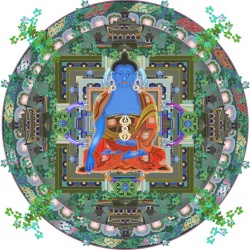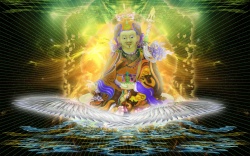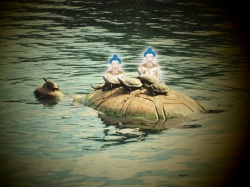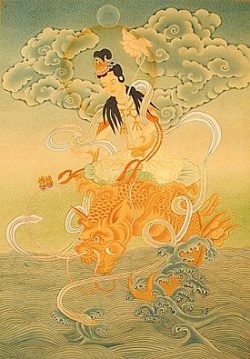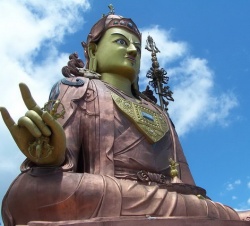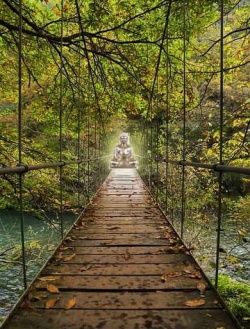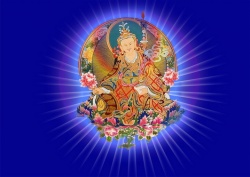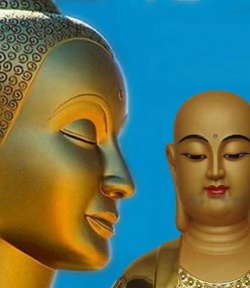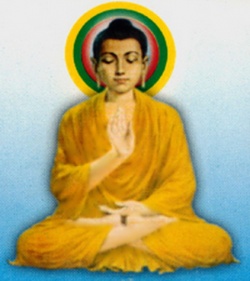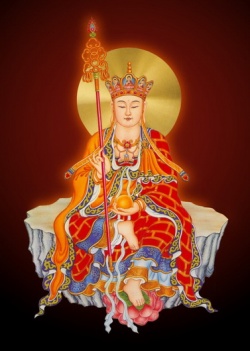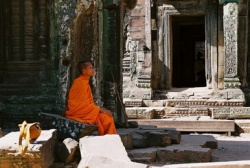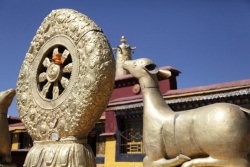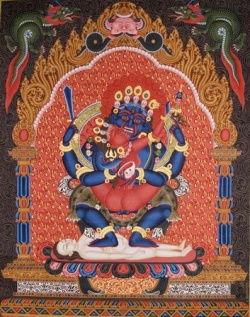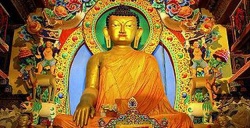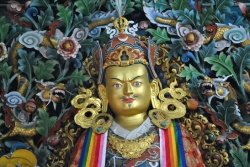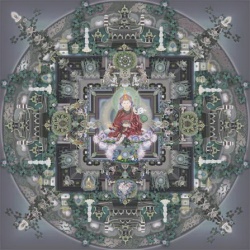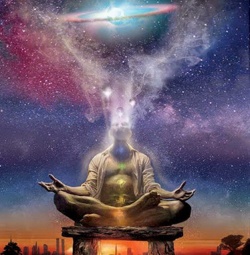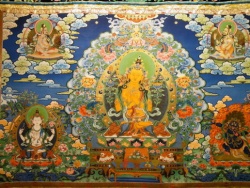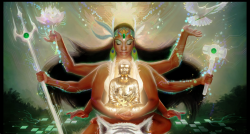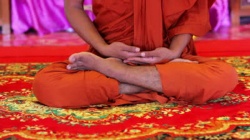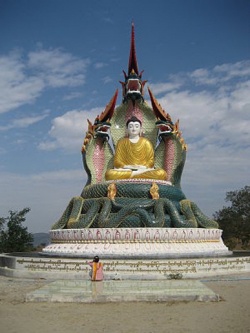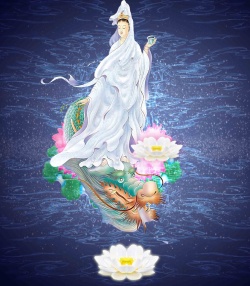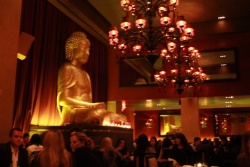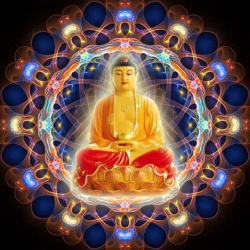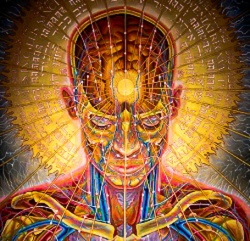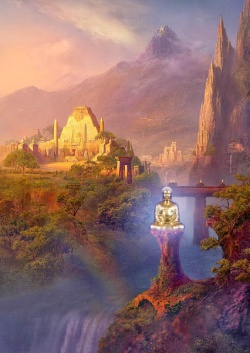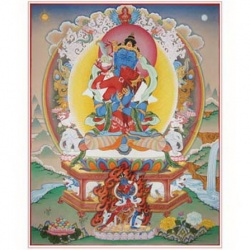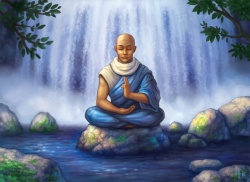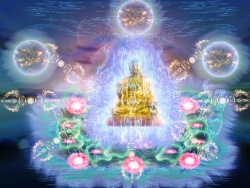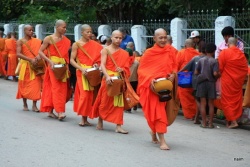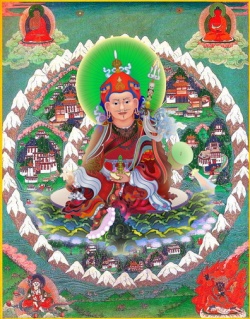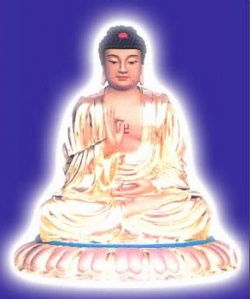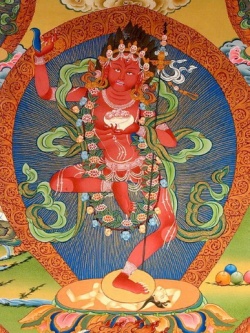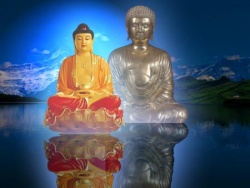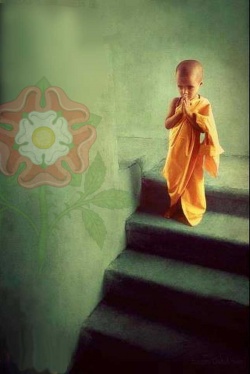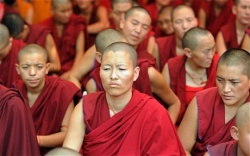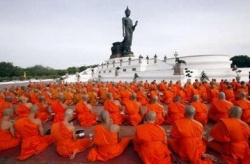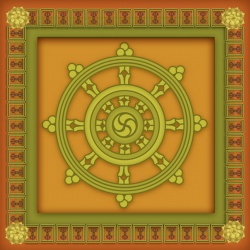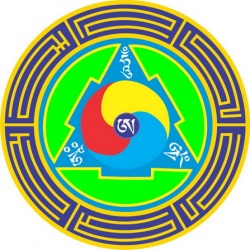The Compendium of Knowledge – Shes-bya Kun-khyab mDzöd
“The Compendium of Knowledge – Shes-bya Kun-khyab mDzöd”
composed by Jamgon Kongtrul Lodrö Thaye the Great
presented by Khenchen Thrangu Rinpoche
at the Thrangu House, Oxford, England, in 1995
4. Abandoning the Two Extremes
The Four Traditions in General
The Madhyamaka Tradition in Particular
Identifying Emptiness
The Rangtong Tradition
4.2.2.1. Sixteen Emptinesses
4.2.2.2. Four Emptinesses
4.2.3. The Shentong Tradition
4.2.3.1. The Threefold Classification
4.2.3.2. Fourteen Emptinesses
4.2.3.3. Two Emptinesses
4. Abandoning the Two Extremes
4.1. The Four Traditions in General
The Root Text:
“After (practicing to purify the mind), one enters the path of giving up the two extremes. Prajna, the subject which knows the ultimate,
cuts through mental elaborations about objects to be known.
Since this is the view of our (Buddhist) tradition,
even those (among us), who assert the existence of things
within their own system, give up permanence and extinction;
however, they (still) fall into the extremes of superimposition and denial.
For this reason, their (views) are (somewhat) true and mostly false.
Since the Madhyamaka tradition realises that the true nature is free of mental elaboration
(and that its) mode of the appearing is dependent arising, it is completely true.”
There are seven sections in the explanation on the view of the middle way, the Madhayamaka. In the fourth section, Jamgon Kongtrul Lodrö Thaye explained how one follows the path so that one will not fall into the two extremes. The middle way is called “Madhyamaka” in Sanskrit and means that - without straying to the left or right - one is going directly down the middle. In terms of the view that realizes the true nature of things, it means not straying into what is called “the view of eternalism” on the one hand and not straying into the view of what is called “nihilism” on the other hand. Avoiding these two extremes, Madhyamikas go the middle way to see the actual and true nature of things.
We should be able to see the true nature of phenomena in meditation. How should we approach meditation? By not straying into one of the two extreme views. How do we avoid falling into one of the two extreme views? By gaining correct understanding of the relative truth and the ultimate truth. Relative truth addresses the delusory appearances that we experience. Even though relative reality is delusory, our conduct should accord with the way things appear.
The Buddha turned the Wheel of Dharma three times. First he presented the teachings on the Four Noble Truths; then he presented the teachings on emptiness, and finally he presented the teachings on the true nature of the mind, which are the teachings on the Buddha nature. After the Buddha passed into Parinirvana, the Indian masters and scholars presented the Buddha’s teachings in a definitive manner and thus four Buddhist traditions developed.
They are the
(1) Vaibhashika,
(2) Sautrantika,
(3) Chittamatra, and
(4) Madhyamaka.
There is a reason for the progressive teachings that the Buddha gave and that are represented in these traditions, namely, to first turn disciples away from actions that are not beneficial and meritorious. Then he gave teachings to turn followers away from believing in a self, and lastly, he presented teachings to establish disciples in the correct view.
(1) The Vaibhashika Tradition.
The Buddha first gave teachings about relative reality so that people would turn away from non-meritorious conduct. If he had first taught about emptiness, students would have wrongly concluded that nothing exists and thus would not have turned away from harmful actions. He taught that things do exist – the mind exists, the body exists, previous lives exist, future lives exist, there is good karma, there is bad karma, there is a self, and there are others. The teachings of the first turning of the Wheel of Dharma are about the reality of all appearances that we perceive. By learning that all appearances and experiences are real, we understand that we should give up bad actions that bring suffering and engage in good actions that bring merit. So, first there are the teachings on how all phenomena that can be known do exist and are real. The Vaibhashika tradition arose from these teachings.
There is a difference between the way things appear and the way things are. Even though there is a difference between the apparent nature and the true nature of things, when the Buddha turned the Wheel of Dharma the first time, he spoke about the apparent nature of things and that bad actions bring bad results and good actions bring good results. For example, one certainly harms others when one kills them and consequently one harms oneself through karma, ‘the infallible law that all actions bring results and all results stem from previous actions.’ This means that bad actions cause bad results and good actions bring good results - for oneself and for others. So, we should do what is beneficial for others and as a result we will also benefit. If we are able to do good actions and avoid bad actions, then we will have the merit of experiencing a positive future. In relation to the apparent nature of all things, Vaibhashikas assert the existence of phenomena and the truth of karma. They teach and study the many different kinds of bad actions and their results and the many different kinds of good actions and their results.
(2) The Sautrantika Tradition.
The next more distinguished tradition is the Sautrantika, which means ‘followers of the Sutras.’ They teach that matter exists, e.g., we have a body and speech, but concepts that are created by the mind do not exist. Looking at the body, from the top of the head to the soles of the feet, they see that the body exists and thus say that actions carried out by the body and speech exist and lead to results. But that which is just a concept of the mind, such as the concept of “self,” has no existence. If asked, “Where is the body?” they point to it and reply, “That is the body that exists.” Since it is not possible to point to the self, they simply state that it does not exist. This is how the Sautrantikas present their teachings and thus avoid falling into one of the two extreme views. The Sautrantikas teach about the selflessness of the person. They do not teach about the selflessness of phenomena, which is the reason they, too, are Hinayana adherents. The next two schools are Mahayana.
(3) The Cittamatra Tradition.
The Cittamatrins teach that all external appearances, our body and so on, are mind. They recognize that there are objects that do appear and are perceived. But they teach that none of those appearances have an external existence, rather, that external appearances arise within our own mind. How can this be? The Cittamatrins point to the fact that we dream while asleep and state that then we see mountains, houses, animals, people, friends, enemies, and so forth, just like we do while awake. They say that no dream-appearance really exists but only arises in our mind. They therefore argue that all appearances that we perceive while awake are only mind. This is why the Cittamatra tradition is called “mind only school.”
The Cittamatrins explain that our mind functions in reliance on latencies that are created by and stored in our mind. If our mind becomes more and more habituated to what is beneficial and good, then gradually our mind and sensations become better and better. If, on the other hand, our mind becomes more and more habituated to something that is harmful and bad, then gradually our mind and sensations become worse and worse. For example, if we control and get rid of a slight feeling of anger when it arises, then it will not remain in our mind as a latency. If we are not stronger than our anger, do not get rid of it when it arises, but cultivate it, then that tendency becomes stronger and stronger. As a result, it will be very hard to rid ourselves of anger when it arises again. So, this is how our mind becomes habituated to anger, but we can also become habituated to love, compassion, and the wish to benefit others.
Emotions can be small in the beginning, but if we cultivate them, they will increase and become more and more powerful. The Cittamatrins therefore say that the mind is dependent upon our tendencies or latencies, whereas all appearances that arise in the mind are imaginary creations of the mind and thus are delusions. For example, the Cittamatrins describe rebirth in hell in the same way, in dependence upon the power and force of anger. By having become habituated to anger, it has increased to the degree that this person sees everyone else as malevolent and out to harm and kill. When this grows extremely strong, that person takes rebirth in hell and experiences people being burned in fire or being chopped up by creatures that run around and do very painful things to others. So, by seeing people in daily life in that way, such a person will become habituated to more and more anger and, in self-defence, will wish and might even try to harm people he thinks are malicious and mean. Furthermore, somebody who becomes habituated to anger sees unpleasant and disturbing things while dreaming and has nightmares while asleep. If, on the other hand, that person develops a peaceful state of mind and has love and compassion for others while awake during the day, he or she will see nice things while dreaming at night. In that way, the power won by developing love, compassion, and the wish to help others throughout a lifetime will determine experiences after death and in the next life. Instead of taking rebirth in hell, that person will be reborn in paradise.
(4) The Madhyamaka Tradition in General.
The most sophisticated tradition is Madhayamaka, ‘the middle way.’ Both Rangtong and Shentong that we will look at shortly are middle way schools. They teach both view and conduct. Conduct relates to the relative truth, which is that every appearance and experience lacks true existence and is delusory. This doesn’t mean to say that relative realities are false, after all, the relative truth is a truth. For example, a seed that is planted in good soil, is watered regularly, and is nourished by the sun will grow into a healthy plant. In the same way, good actions will be the cause of good results and bad actions will be the cause of bad results. Therefore the Madhyamikas teach that our conduct must accord with the law of cause and effect. In the context of the relative truth, it is necessary to avoid and give up what is negative or bad and to try to adopt and increase virtuous qualities. In the Mahayana tradition, good conduct means practicing the six perfections, which are generosity, patience, and so forth. Then there will be good results due to the law of the relative truth. The ultimate truth is the truth of emptiness. The ultimate truth is that all appearances and experiences are without any reality. By realizing emptiness, we will have eliminated suffering and our fear of samsara.
The Madhyamaka Tradition in Particular
4.2.1. Identifying Emptiness
What is emptiness? How do we identify emptiness? What are things empty of? Emptiness applies to the two kinds of self, the self of persons and the self of phenomena. The self of a person is the thought “I” and “me,” which is empty of inherent existence. The self of phenomena is the belief in the reality of appearances and experiences, which are in truth devoid of a self. This is what emptiness refers to - the selflessness of a person and the selflessness of phenomena.
4.2.3. The Rangtong Tradition
“The object of its view is emptiness.
(The Yogachara Madhyamaka) explains it as the (ultimate) ‘thing’ (which results from) having negated the two selves;
(the Rangtong explain it) from the perspective of a non-affirming negation.
The basis for emptiness is all phenomena.
What is to be negated is the very basis of negation.
Its mode of emptiness is non-existence in the sense of having no essence.
This is the (view of) the Rangtong system.
There are sixteen divisions: outer, inner, emptiness, and so forth.”
The Rangtongs teach that all phenomena are without any reality. The Buddha listed sixteen emptinesses that are recorded in the Sutras.
4.2.2.1. Sixteen Emptinesses
The sixteen emptinesses are:
(1) External emptiness;
(2) internal emptiness;
(3) external and internal emptiness;
(4) the emptiness of emptiness;
(5) great emptiness;
(6) emptiness of the ultimate;
(7) emptiness of the composite;
(8) emptiness of the non-composite;
(9) emptiness of the transcendence of extremes;
(10) emptiness of that which is beginningless and endless;
(11) emptiness of that which is not discarded;
(12) emptiness of nature;
(13) emptiness of all dharmas (‘phenomena’);
(14) emptiness of specific characteristics;
(15) emptiness of non-perception; and
(16) emptiness of the essence of the non-existence of things.
(1) External emptiness applies to all external appearances – mountains, forests, houses, and every object that we perceive with our senses and sensory consciousnesses. For example, our eye has the visual consciousness and perceives an external phenomenon that has a form and shape. Forms have no true reality and are therefore empty. Similarly, our oral consciousness of our ear organ perceives sounds that have no true reality either. This applies to the consciousnesses of our nose, tongue, and physical body; they perceive scents, tastes, and tactile objects, respectively. Next to the five sensory consciousnesses, our sixth mental consciousness apperceives a vast range of phenomena. So, there are the six external objects that we perceive with our six inner consciousnesses. All outer objects that we perceive and apperceive are without any reality and so there is “external emptiness.”
It is difficult to believe that all external phenomena have no reality, that their true nature is emptiness. When we first hear about this, we might think, “Well, I can see all these things. There are mountains, rivers, forests, houses, and so many things that I can see. They do exist.” But if we examine carefully, we will discover that all those things lack real existence. For example, I am clasping two sticks in my hand. One is long and the other one is short. We think, “There is no mistake in that. We can’t deny that one is long and the other one is short.” But that is just a mental fabrication because, by pulling the shorter one higher, the longer one becomes the shorter one. Phenomena are empty of being long or short, i.e., there is no long and short as such. It is the same for other things created by our mind. There is no big or small, beautiful or ugly, good or bad. All these thoughts are just creations of our mind and have no reality of their own. This is what is called “external emptiness.” We might accept this and think, “Okay, there is no reality to the ideas of long and short, but things exist.” We have a general impression that there are all these things and conclude that they have true existence. But we can examine and see that this is not so. By examining, we find that no phenomenon is either unitary or multiple, one thing or many things. For example, when we see a hand, we think, “This is a hand.” Everyone will agree and say, “Yes, it is a hand.” By going through the hand, everyone will agree that a thumb is a thumb and is not a hand and that an index finger is an index finger and is not a hand. The same with the middle finger, the ring finger, the skin, the flesh, the bones, and so on. We ask, “Well, where is the hand?” Not one single spot of what we call “hand” is the hand. In fact, a hand is a collection of many different components, so there is no such thing as a hand that is self-existent. The same with a house. We can go through all parts of a house and know that the pillar is not the house; the beams aren’t either, and so on. Just as a hand and a house do not exist the way we think, mountains and people are also not independent existents. Nothing will ever be found to exist independently, which is what external emptiness refers to.
(2) Internal emptiness: We apperceive objects with our six consciousnesses. Although a hand, for example, has no inherent existence, we see and apperceive a hand by means of our visual sensory organ, visual sensory faculty, and visual consciousness. But if a hand has no real existence, then the visual consciousness does not have an own existence either. This is true for all sensory organs, faculties, and consciousnesses as well. Since objects of perception have no reality, the consciousnesses that apperceive them have no reality either.
(3) External and internal emptiness: If external objects and the respective consciousnesses that apperceive them have no true existence, then how can perception take place? How is it possible to see something if there is no visual consciousness and no reality to the object that we see? The same for hearing and so on. The process taking place when connecting one of the consciousnesses with an object that it can perceive is called “external and internal emptiness.”
(4) The emptiness of emptiness: We established the emptiness of external phenomena, of the inner consciousnesses, and of the connection between them. There is emptiness, but we might think, “Well, this emptiness exists.” In fact, emptiness does not exist. Emptiness itself has no real existence of its own, which is the fourth emptiness.
(5) Great emptiness: The fifth emptiness is also called “the vast emptiness.” When we think of directions - north, south, east, and west – we think of them as being real. But, in fact, they are just creations of our mind. We can think that we are presently in the west, but in relation to the U.S., we are in the east. Directions are just mental constructs and are devoid of any reality.
(6) Emptiness of the ultimate: It is impossible to establish an ultimate reality, so there is emptiness of the ultimate.
(7) Emptiness of the composite: All external and internal phenomena have no reality, so there is emptiness of the composite.
(8) Emptiness of the non-composite: If composites have no reality, then non-composites have no reality either.
(9) Emptiness of the transcendence of extremes: There are the two extremes of eternalism and nihilism. Both lack an own reality. Therefore their transcendence also lacks reality.
(10) Emptiness of that which is beginningless and endless: The very ideas “beginning” and “end” have no reality. For instance, we can say that the middle of the night is the end or the beginning of the day. Also, samsara is without a beginning and without an end because it is without a reality of its own. That which has no beginning or end is emptiness.
(11) Emptiness of that which is not discarded: We want to eliminate samsara and all its shortcomings and aspire to attain liberation, nirvana. We do not want to eliminate or discard nirvana; rather, we aspire to attain it. Samsara has no reality. Therefore nirvana has no reality.
(12) Emptiness of nature: We might think that there are all the phenomena and that they have an own nature. There is no reality to their nature, so there is the emptiness of nature.
(13) Emptiness of all dharmas (‘phenomena’): Every appearance and experience is empty of intrinsic reality.
(14) Emptiness of specific characteristics: Things have specific characteristics, but they have no reality.
(15) Emptiness of the non-existence of things refers to non-apprehension of phenomena. It also has no reality.
(16) Emptiness of the essence of the non-existence of things: The sixteenth emptiness is the emptiness of the absence of things, the emptiness of nothingness. Things have no reality, so their absence has no reality either.
Those are the sixteen emptinesses that the Buddha taught in the “Prajnaparamitasutra” (‘The Perfection of Wisdom Sutra’). These teachings establish that all relative phenomena that arise through dependent origination have no reality of their own and are thus empty of an own nature. It is the view of the Rangtongs, who teach that all things are empty of an own nature.
4.2.2.2. Four Emptinesses
“These (the sixteen emptinesses) are summarized as four: emptiness of things, non-things, nature, and other (‘thing’).”
When the sixteen emptinesses are summarized, there are four. They are: (1) Emptiness of things; (2) emptiness of the non-existence of things; (3) emptiness of nature; and (4) emptiness of that which is other.
We have the explanation of the Madhyamaka, so we are able to learn about the view of emptiness and the two selflessnesses. We have looked at the middle way according to the Rangtong tradition and will now look at the Shentong tradition, which presents the list of emptinesses in a slightly different way than the Rangtongs.
4.2.3. The Shentong Tradition
Generally, there is view, meditation, and conduct. Jamgon Kongtrul Lodrö Thaye wrote about the view in the section of “The Compendium of Knowledge” that we are studying together.
Many people study and practice the teachings diligently, but they do not arrive at a result. Many Lamas are unhappy that they have not been able to lead their disciples to realisations. Pupils are also unhappy and think, “I haven’t been able to gain realisations and experiences haven’t arisen in my mind.” The reason for this is that many Lamas emphasise view and meditation but do not speak about correct conduct. There is the accumulation of wisdom and the accumulation of merit. Many Lamas emphasize the accumulation of wisdom and treat the accumulation of merit as insignificant. This is the reason results are not achieved. For example, three years ago I travelled to So. America to teach and my interpreter advised me and said, “There are three subjects you should not talk about. People do not like hearing about karma, about the suffering in lower existences, nor about samsara. It is better not to mention them. People will not object to teachings about love, compassion, and Bodhicitta, but it would be better to speak about emptiness and no self. People really like that. Even though lots of people do not understand it, they like hearing about it because they think it is really profound.” I spoke about emptiness and selflessness and the next day a participant remarked, “I didn’t sleep all night because I was wondering what emptiness means.” One needs to receive teachings on both conduct and the view. If one does not have correct conduct, then one’s Dharma practice will not bring beneficial results.
I am teaching about the view in this course, but we should not forget the practice of good conduct. We should keep the practice of good actions and good speech in mind all day, every day of the month, and should not forget them throughout our entire life. We should practice good actions with our body, use pleasant speech, and use our possessions wisely. We should avoid bad actions, negative speech, and not make bad use of our belongings. If we are able to accumulate merit by doing good things, then it will be impossible not to achieve beneficial results from learning and meditating the view. Our practice will be fruitful if we accumulate virtuous merit.
4.2.3.1. The Threefold Classification
“The basis is the perfectly existent nature; the object of negation is the imputed and dependent natures.
(The perfectly existent) is empty of these (two), so state the Yogachara (Madhaymakas).
They assert fourteen (divisions), which are summarized into two.”
What is the difference between the view of Rangtong and Shentong? The Shentongs speak of the three distinguishing characteristics of nature. They are: (1) That which is imaginary, the conceptually constructed nature (parakalpita in Sanskrit); (2) that which is dependent, the dependent or contingent nature (paratantra in Sanskrit); and (3) that which is completely perfect, the actual nature (parinishpana).
(1) That which is imaginary: The first distinguishing characteristic of phenomena is the imaginary, i.e., the conceptually constructed nature (kun-brtags in Tibetan). This means that things are just a fabrication of our mind’s attachments, e.g., our mind thinks, “This is what this is and that is what that is.” Thoughts are just conceptual constructs of the mind.
(2) That which is dependent (gzhän-dbang in Tibetan): Although appearances are empty and illusory, they are constructed and apprehended by the mind. Thoughts arise to our mind due to the power of our mind’s latencies or tendencies that we created in a previous life or lives. This definite process is taking place, but appearances have no reality and their nature is empty. The experience of the arising of appearances to our mind is called “the dependent nature.” Being attached to those dependent appearances by thinking they are real is an illusion.
The three distinguishing characteristics of nature are taught in the Shentong tradition. The first characteristic is the conceptually constructed nature. Then there is the dependent or contingent nature, and finally there is the completely perfect nature. Both the first and second are empty of real existence. This emptiness is the third distinguishing characteristic, that which is the completely perfect, i.e., the actual nature.
(3) That which is completely perfect (yongs-grub in Tibetan) is dharmadhatu, chös-kyi-dbyings, ‘the expanse of phenomena.’ The term “expanse” describes limitless and unrestrictive space. Dharmadhatu, ‘the nature of phenomena,’ is the vast expanse in and due to which knowledge and all qualities of realization can arise and develop. It is the source of everything. Although dharmadhatu is compared to space, it is not vacuous space that excludes the mind. Dharmadhatu is a space in and due to which all qualities of the mind arise and evolve. There are conceptually constructed fabrications, appearances that arise in dependence, and their true nature which is perfect and clear. “Dharma” in the term “dharmadhatu” refers to all outer and inner things that arise, change, develop, and progress; “expanse” means that all outer and inner things have this ability and are not restricted and not impeded from doing so.
“Parinishpana” is another Sanskrit term for dharmadhatu and means ‘the actual perfect nature.’ The actual perfect nature is the basis and source of all good qualities that can arise in and through dharmadhatu. Since everything - good and bad, beneficial and harmful - can arise in and through it, a few great masters described dharmadhatu as “the supreme emptiness that has all aspects.” Where do ordinary living beings come from? From the emptiness that is replete with all aspects, dharmadhatu, the true nature of reality. A Buddha’s body, the pure realms, all qualities of complete and perfect Buddhahood manifest from dharmadhatu, which is the actual nature of all inner and outer phenomena.
Dharmadhatu is not empty space but is the vastness of space that is clarity and wisdom. There is the expanse of space in and by which everything can flourish and blossom and there is knowing and wisdom. Therefore dharmadhatu is also called “the union of space and wisdom.” Dharmadhatu is the basis and source of wisdom and all qualities of being. Everything arises and evolves in, due to, and from the actual true nature.
Rangtongs and Shentongs explain that all relative appearances have no reality of their own, arise due to dependent origination, and are devoid of an own nature. Rangtong (spelled rang-stong in Tibetan) means ‘empty of self.’ The difference between the Rangtong and Shentong traditions is that the Shentongs discuss the three distinguishing characteristics of nature - the conceptually constructed nature, the dependent nature, and the actual nature. Rangtongs agree with Shentongs that impure and illusory conceptual constructs and dependence are empty of an own nature, but the Rangtongs state that they are separate from the basic state of complete perfection. Shentong (spelled gzhän-stong in Tibetan) means ‘empty of other,’ whereby “other” refers to the first two impure and illusory distinguishing characteristics. The Shentongs show that the state of perfection is the union of wisdom and space which is free of impurities that are other than fully established perfection.
4.2.3.2. Fourteen Emptinesses
The Shentong tradition speaks of fourteen emptinesses that differ slightly from the sixteen listed by the Rangtongs. First a group of fourteen and then a group of two are taught by Shentongs.
The fourteen emptinesses are:
(1) Internal emptiness;
(2) external emptiness;
(3) internal and external emptiness;
(4) great emptiness;
(5) emptiness of emptiness;
(6) emptiness of the ultimate;
(7) emptiness of the composite;
(8) emptiness of the non-composite;
(9) emptiness of the transcendence of extremes; (
10) emptiness of that which is beginningless and endless;
(11) emptiness of that which is not eliminated;
(12) emptiness of nature;
(13) emptiness of characteristics; and
(14) emptiness of dharmas (‘qualities’).
The first four emptinesses apply to both Hinayana and Mahayana followers. As to phenomena within relative reality:
(1) Internal emptiness pertains to the first six consciousnesses that apperceive what has been perceived. They are without any reality of their own and are thus empty.
(2) External emptiness pertains to objects that are apperceived by the six consciousnesses.
(3) Internal and external emptiness pertains to the emptiness of the physical bases of the body, i.e., the skin, sensory organs, etc., by which apperception occurs.
(4) Great emptiness is the world of being. It, too, is empty.
The next two emptinesses are ultimate truths:
(5) Emptiness of emptiness is taught to eliminate attachment to emptiness as being solid and real. It refers to the vast expanse of emptiness.
(6) Emptiness of the ultimate pertains to the expanse of clarity. It means that the true nature of clarity is emptiness. It is taught to remedy attachment to the thought that clarity is a solid, self-existing reality.
Emptinesses 7 -14 pertain to specific phenomena and 7 - 10 to Mahayana in general.
(7) & (8) Emptiness of the composite & emptiness of the non-composite: Without being attached to them as true realities, a Bodhisattva practices both what is composite, which is the accumulation of merit, and what is non-composite, which is the accumulation of wisdom. Composites and non-composites have no true existence.
(9) Appreciating and acknowledging emptiness of the transcendence of extremes benefits oneself. Dharmadhatu is beyond the extreme of existence and non-existence and should be seen as true. In our practice of meditation, we see that nothing has own existence. Therefore there are the teachings about that which is beyond extremes.
(10) Appreciating and acknowledging emptiness of that which is beginningless and endless also benefits others. Bodhisattvas continually work for the benefit of all living beings and should not think they have a true existence and thus be attached to them. There are two extremes that must be avoided, the extreme of existence and the Gaining Certainty of the View – Part 2/6
Instructions on Chapter 7.3 of
“The Compendium of Knowledge – Shes-bya Kun-khyab mDzöd”
composed by Jamgon Kongtrul Lodrö Thaye the Great
presented by Khenchen Thrangu Rinpoche
at the Thrangu House, Oxford, England, in 1995
4. Abandoning the Two Extremes
The Four Traditions in General
The Madhyamaka Tradition in Particular
Identifying Emptiness
The Rangtong Tradition
4.2.2.1. Sixteen Emptinesses
4.2.2.2. Four Emptinesses
4.2.3. The Shentong Tradition
4.2.3.1. The Threefold Classification
4.2.3.2. Fourteen Emptinesses
4.2.3.3. Two Emptinesses
4. Abandoning the Two Extremes
4.1. The Four Traditions in General
The Root Text:
“After (practicing to purify the mind), one enters the path of giving up the two extremes. Prajna, the subject which knows the ultimate,
cuts through mental elaborations about objects to be known.
Since this is the view of our (Buddhist) tradition,
even those (among us), who assert the existence of things
within their own system, give up permanence and extinction;
however, they (still) fall into the extremes of superimposition and denial.
For this reason, their (views) are (somewhat) true and mostly false.
Since the Madhyamaka tradition realises that the true nature is free of mental elaboration
(and that its) mode of the appearing is dependent arising, it is completely true.”
There are seven sections in the explanation on the view of the middle way, the Madhayamaka. In the fourth section, Jamgon Kongtrul Lodrö Thaye explained how one follows the path so that one will not fall into the two extremes. The middle way is called “Madhyamaka” in Sanskrit and means that - without straying to the left or right - one is going directly down the middle. In terms of the view that realizes the true nature of things, it means not straying into what is called “the view of eternalism” on the one hand and not straying into the view of what is called “nihilism” on the other hand. Avoiding these two extremes, Madhyamikas go the middle way to see the actual and true nature of things.
We should be able to see the true nature of phenomena in meditation. How should we approach meditation? By not straying into one of the two extreme views. How do we avoid falling into one of the two extreme views? By gaining correct understanding of the relative truth and the ultimate truth. Relative truth addresses the delusory appearances that we experience. Even though relative reality is delusory, our conduct should accord with the way things appear.
The Buddha turned the Wheel of Dharma three times. First he presented the teachings on the Four Noble Truths; then he presented the teachings on emptiness, and finally he presented the teachings on the true nature of the mind, which are the teachings on the Buddha nature. After the Buddha passed into Parinirvana, the Indian masters and scholars presented the Buddha’s teachings in a definitive manner and thus four Buddhist traditions developed.
They are the
(1) Vaibhashika,
(2) Sautrantika,
(3) Chittamatra, and
(4) Madhyamaka.
There is a reason for the progressive teachings that the Buddha gave and that are represented in these traditions, namely, to first turn disciples away from actions that are not beneficial and meritorious. Then he gave teachings to turn followers away from believing in a self, and lastly, he presented teachings to establish disciples in the correct view.
(1) The Vaibhashika Tradition.
The Buddha first gave teachings about relative reality so that people would turn away from non-meritorious conduct. If he had first taught about emptiness, students would have wrongly concluded that nothing exists and thus would not have turned away from harmful actions. He taught that things do exist – the mind exists, the body exists, previous lives exist, future lives exist, there is good karma, there is bad karma, there is a self, and there are others. The teachings of the first turning of the Wheel of Dharma are about the reality of all appearances that we perceive. By learning that all appearances and experiences are real, we understand that we should give up bad actions that bring suffering and engage in good actions that bring merit. So, first there are the teachings on how all phenomena that can be known do exist and are real. The Vaibhashika tradition arose from these teachings.
There is a difference between the way things appear and the way things are. Even though there is a difference between the apparent nature and the true nature of things, when the Buddha turned the Wheel of Dharma the first time, he spoke about the apparent nature of things and that bad actions bring bad results and good actions bring good results. For example, one certainly harms others when one kills them and consequently one harms oneself through karma, ‘the infallible law that all actions bring results and all results stem from previous actions.’ This means that bad actions cause bad results and good actions bring good results - for oneself and for others. So, we should do what is beneficial for others and as a result we will also benefit. If we are able to do good actions and avoid bad actions, then we will have the merit of experiencing a positive future. In relation to the apparent nature of all things, Vaibhashikas assert the existence of phenomena and the truth of karma. They teach and study the many different kinds of bad actions and their results and the many different kinds of good actions and their results.
(2) The Sautrantika Tradition.
The next more distinguished tradition is the Sautrantika, which means ‘followers of the Sutras.’ They teach that matter exists, e.g., we have a body and speech, but concepts that are created by the mind do not exist. Looking at the body, from the top of the head to the soles of the feet, they see that the body exists and thus say that actions carried out by the body and speech exist and lead to results. But that which is just a concept of the mind, such as the concept of “self,” has no existence. If asked, “Where is the body?” they point to it and reply, “That is the body that exists.” Since it is not possible to point to the self, they simply state that it does not exist. This is how the Sautrantikas present their teachings and thus avoid falling into one of the two extreme views. The Sautrantikas teach about the selflessness of the person. They do not teach about the selflessness of phenomena, which is the reason they, too, are Hinayana adherents. The next two schools are Mahayana.
(3) The Cittamatra Tradition.
The Cittamatrins teach that all external appearances, our body and so on, are mind. They recognize that there are objects that do appear and are perceived. But they teach that none of those appearances have an external existence, rather, that external appearances arise within our own mind. How can this be? The Cittamatrins point to the fact that we dream while asleep and state that then we see mountains, houses, animals, people, friends, enemies, and so forth, just like we do while awake. They say that no dream-appearance really exists but only arises in our mind. They therefore argue that all appearances that we perceive while awake are only mind. This is why the Cittamatra tradition is called “mind only school.”
The Cittamatrins explain that our mind functions in reliance on latencies that are created by and stored in our mind. If our mind becomes more and more habituated to what is beneficial and good, then gradually our mind and sensations become better and better. If, on the other hand, our mind becomes more and more habituated to something that is harmful and bad, then gradually our mind and sensations become worse and worse. For example, if we control and get rid of a slight feeling of anger when it arises, then it will not remain in our mind as a latency. If we are not stronger than our anger, do not get rid of it when it arises, but cultivate it, then that tendency becomes stronger and stronger. As a result, it will be very hard to rid ourselves of anger when it arises again. So, this is how our mind becomes habituated to anger, but we can also become habituated to love, compassion, and the wish to benefit others.
Emotions can be small in the beginning, but if we cultivate them, they will increase and become more and more powerful. The Cittamatrins therefore say that the mind is dependent upon our tendencies or latencies, whereas all appearances that arise in the mind are imaginary creations of the mind and thus are delusions. For example, the Cittamatrins describe rebirth in hell in the same way, in dependence upon the power and force of anger. By having become habituated to anger, it has increased to the degree that this person sees everyone else as malevolent and out to harm and kill. When this grows extremely strong, that person takes rebirth in hell and experiences people being burned in fire or being chopped up by creatures that run around and do very painful things to others. So, by seeing people in daily life in that way, such a person will become habituated to more and more anger and, in self-defence, will wish and might even try to harm people he thinks are malicious and mean. Furthermore, somebody who becomes habituated to anger sees unpleasant and disturbing things while dreaming and has nightmares while asleep. If, on the other hand, that person develops a peaceful state of mind and has love and compassion for others while awake during the day, he or she will see nice things while dreaming at night. In that way, the power won by developing love, compassion, and the wish to help others throughout a lifetime will determine experiences after death and in the next life. Instead of taking rebirth in hell, that person will be reborn in paradise.
(4) The Madhyamaka Tradition in General.
The most sophisticated tradition is Madhayamaka, ‘the middle way.’ Both Rangtong and Shentong that we will look at shortly are middle way schools. They teach both view and conduct. Conduct relates to the relative truth, which is that every appearance and experience lacks true existence and is delusory. This doesn’t mean to say that relative realities are false, after all, the relative truth is a truth. For example, a seed that is planted in good soil, is watered regularly, and is nourished by the sun will grow into a healthy plant. In the same way, good actions will be the cause of good results and bad actions will be the cause of bad results. Therefore the Madhyamikas teach that our conduct must accord with the law of cause and effect. In the context of the relative truth, it is necessary to avoid and give up what is negative or bad and to try to adopt and increase virtuous qualities. In the Mahayana tradition, good conduct means practicing the six perfections, which are generosity, patience, and so forth. Then there will be good results due to the law of the relative truth. The ultimate truth is the truth of emptiness. The ultimate truth is that all appearances and experiences are without any reality. By realizing emptiness, we will have eliminated suffering and our fear of samsara.
The Madhyamaka Tradition in Particular
4.2.1. Identifying Emptiness
What is emptiness? How do we identify emptiness? What are things empty of? Emptiness applies to the two kinds of self, the self of persons and the self of phenomena. The self of a person is the thought “I” and “me,” which is empty of inherent existence. The self of phenomena is the belief in the reality of appearances and experiences, which are in truth devoid of a self. This is what emptiness refers to - the selflessness of a person and the selflessness of phenomena.
4.2.3. The Rangtong Tradition
“The object of its view is emptiness.
(The Yogachara Madhyamaka) explains it as the (ultimate) ‘thing’ (which results from) having negated the two selves;
(the Rangtong explain it) from the perspective of a non-affirming negation.
The basis for emptiness is all phenomena.
What is to be negated is the very basis of negation.
Its mode of emptiness is non-existence in the sense of having no essence.
This is the (view of) the Rangtong system.
There are sixteen divisions: outer, inner, emptiness, and so forth.”
The Rangtongs teach that all phenomena are without any reality. The Buddha listed sixteen emptinesses that are recorded in the Sutras.
4.2.2.1. Sixteen Emptinesses
The sixteen emptinesses are: (1) External emptiness; (2) internal emptiness; (3) external and internal emptiness; (4) the emptiness of emptiness; (5) great emptiness; (6) emptiness of the ultimate; (7) emptiness of the composite; (8) emptiness of the non-composite; (9) emptiness of the transcendence of extremes; (10) emptiness of that which is beginningless and endless; (11) emptiness of that which is not discarded; (12) emptiness of nature; (13) emptiness of all dharmas (‘phenomena’); (14) emptiness of specific characteristics; (15) emptiness of non-perception; and (16) emptiness of the essence of the non-existence of things.
(1) External emptiness applies to all external appearances – mountains, forests, houses, and every object that we perceive with our senses and sensory consciousnesses. For example, our eye has the visual consciousness and perceives an external phenomenon that has a form and shape. Forms have no true reality and are therefore empty. Similarly, our oral consciousness of our ear organ perceives sounds that have no true reality either. This applies to the consciousnesses of our nose, tongue, and physical body; they perceive scents, tastes, and tactile objects, respectively. Next to the five sensory consciousnesses, our sixth mental consciousness apperceives a vast range of phenomena. So, there are the six external objects that we perceive with our six inner consciousnesses. All outer objects that we perceive and apperceive are without any reality and so there is “external emptiness.”
It is difficult to believe that all external phenomena have no reality, that their true nature is emptiness. When we first hear about this, we might think, “Well, I can see all these things. There are mountains, rivers, forests, houses, and so many things that I can see. They do exist.” But if we examine carefully, we will discover that all those things lack real existence. For example, I am clasping two sticks in my hand. One is long and the other one is short. We think, “There is no mistake in that. We can’t deny that one is long and the other one is short.” But that is just a mental fabrication because, by pulling the shorter one higher, the longer one becomes the shorter one. Phenomena are empty of being long or short, i.e., there is no long and short as such.
It is the same for other things created by our mind. There is no big or small, beautiful or ugly, good or bad. All these thoughts are just creations of our mind and have no reality of their own. This is what is called “external emptiness.” We might accept this and think, “Okay, there is no reality to the ideas of long and short, but things exist.” We have a general impression that there are all these things and conclude that they have true existence. But we can examine and see that this is not so. By examining, we find that no phenomenon is either unitary or multiple, one thing or many things. For example, when we see a hand, we think, “This is a hand.” Everyone will agree and say, “Yes, it is a hand.” By going through the hand, everyone will agree that a thumb is a thumb and is not a hand and that an index finger is an index finger and is not a hand. The same with the middle finger, the ring finger, the skin, the flesh, the bones, and so on. We ask, “Well, where is the hand?” Not one single spot of what we call “hand” is the hand. In fact, a hand is a collection of many different components, so there is no such thing as a hand that is self-existent. The same with a house. We can go through all parts of a house and know that the pillar is not the house; the beams aren’t either, and so on. Just as a hand and a house do not exist the way we think, mountains and people are also not independent existents. Nothing will ever be found to exist independently, which is what external emptiness refers to.
(2) Internal emptiness: We apperceive objects with our six consciousnesses. Although a hand, for example, has no inherent existence, we see and apperceive a hand by means of our visual sensory organ, visual sensory faculty, and visual consciousness. But if a hand has no real existence, then the visual consciousness does not have an own existence either. This is true for all sensory organs, faculties, and consciousnesses as well. Since objects of perception have no reality, the consciousnesses that apperceive them have no reality either.
(3) External and internal emptiness: If external objects and the respective consciousnesses that apperceive them have no true existence, then how can perception take place? How is it possible to see something if there is no visual consciousness and no reality to the object that we see? The same for hearing and so on. The process taking place when connecting one of the consciousnesses with an object that it can perceive is called “external and internal emptiness.”
(4) The emptiness of emptiness: We established the emptiness of external phenomena, of the inner consciousnesses, and of the connection between them. There is emptiness, but we might think, “Well, this emptiness exists.” In fact, emptiness does not exist. Emptiness itself has no real existence of its own, which is the fourth emptiness.
(5) Great emptiness: The fifth emptiness is also called “the vast emptiness.” When we think of directions - north, south, east, and west – we think of them as being real. But, in fact, they are just creations of our mind. We can think that we are presently in the west, but in relation to the U.S., we are in the east. Directions are just mental constructs and are devoid of any reality.
(6) Emptiness of the ultimate: It is impossible to establish an ultimate reality, so there is emptiness of the ultimate.
(7) Emptiness of the composite: All external and internal phenomena have no reality, so there is emptiness of the composite.
(8) Emptiness of the non-composite: If composites have no reality, then non-composites have no reality either.
(9) Emptiness of the transcendence of extremes: There are the two extremes of eternalism and nihilism. Both lack an own reality. Therefore their transcendence also lacks reality.
(10) Emptiness of that which is beginningless and endless: The very ideas “beginning” and “end” have no reality. For instance, we can say that the middle of the night is the end or the beginning of the day. Also, samsara is without a beginning and without an end because it is without a reality of its own. That which has no beginning or end is emptiness.
(11) Emptiness of that which is not discarded: We want to eliminate samsara and all its shortcomings and aspire to attain liberation, nirvana. We do not want to eliminate or discard nirvana; rather, we aspire to attain it. Samsara has no reality. Therefore nirvana has no reality.
(12) Emptiness of nature: We might think that there are all the phenomena and that they have an own nature. There is no reality to their nature, so there is the emptiness of nature.
(13) Emptiness of all dharmas (‘phenomena’): Every appearance and experience is empty of intrinsic reality.
(14) Emptiness of specific characteristics: Things have specific characteristics, but they have no reality.
(15) Emptiness of the non-existence of things refers to non-apprehension of phenomena. It also has no reality.
(16) Emptiness of the essence of the non-existence of things: The sixteenth emptiness is the emptiness of the absence of things, the emptiness of nothingness. Things have no reality, so their absence has no reality either.
Those are the sixteen emptinesses that the Buddha taught in the “Prajnaparamitasutra” (‘The Perfection of Wisdom Sutra’). These teachings establish that all relative phenomena that arise through dependent origination have no reality of their own and are thus empty of an own nature. It is the view of the Rangtongs, who teach that all things are empty of an own nature.
4.2.2.2. Four Emptinesses
“These (the sixteen emptinesses) are summarized as four: emptiness of things, non-things, nature, and other (‘thing’).”
When the sixteen emptinesses are summarized, there are four. They are: (1) Emptiness of things; (2) emptiness of the non-existence of things; (3) emptiness of nature; and (4) emptiness of that which is other.
We have the explanation of the Madhyamaka, so we are able to learn about the view of emptiness and the two selflessnesses. We have looked at the middle way according to the Rangtong tradition and will now look at the Shentong tradition, which presents the list of emptinesses in a slightly different way than the Rangtongs.
4.2.3. The Shentong Tradition
Generally, there is view, meditation, and conduct. Jamgon Kongtrul Lodrö Thaye wrote about the view in the section of “The Compendium of Knowledge” that we are studying together.
Many people study and practice the teachings diligently, but they do not arrive at a result. Many Lamas are unhappy that they have not been able to lead their disciples to realisations. Pupils are also unhappy and think, “I haven’t been able to gain realisations and experiences haven’t arisen in my mind.” The reason for this is that many Lamas emphasise view and meditation but do not speak about correct conduct. There is the accumulation of wisdom and the accumulation of merit. Many Lamas emphasize the accumulation of wisdom and treat the accumulation of merit as insignificant. This is the reason results are not achieved. For example, three years ago I travelled to So. America to teach and my interpreter advised me and said, “There are three subjects you should not talk about. People do not like hearing about karma, about the suffering in lower existences, nor about samsara. It is better not to mention them. People will not object to teachings about love, compassion, and Bodhicitta, but it would be better to speak about emptiness and no self. People really like that. Even though lots of people do not understand it, they like hearing about it because they think it is really profound.” I spoke about emptiness and selflessness and the next day a participant remarked, “I didn’t sleep all night because I was wondering what emptiness means.” One needs to receive teachings on both conduct and the view. If one does not have correct conduct, then one’s Dharma practice will not bring beneficial results.
I am teaching about the view in this course, but we should not forget the practice of good conduct. We should keep the practice of good actions and good speech in mind all day, every day of the month, and should not forget them throughout our entire life. We should practice good actions with our body, use pleasant speech, and use our possessions wisely. We should avoid bad actions, negative speech, and not make bad use of our belongings. If we are able to accumulate merit by doing good things, then it will be impossible not to achieve beneficial results from learning and meditating the view. Our practice will be fruitful if we accumulate virtuous merit.
4.2.3.1. The Threefold Classification
“The basis is the perfectly existent nature; the object of negation is the imputed and dependent natures.
(The perfectly existent) is empty of these (two), so state the Yogachara (Madhaymakas).
They assert fourteen (divisions), which are summarized into two.”
What is the difference between the view of Rangtong and Shentong? The Shentongs speak of the three distinguishing characteristics of nature.
They are:
(1) That which is imaginary, the conceptually constructed nature (parakalpita in Sanskrit);
(2) that which is dependent, the dependent or contingent nature (paratantra in Sanskrit); and
(3) that which is completely perfect, the actual nature (parinishpana).
(1) That which is imaginary: The first distinguishing characteristic of phenomena is the imaginary, i.e., the conceptually constructed nature (kun-brtags in Tibetan). This means that things are just a fabrication of our mind’s attachments, e.g., our mind thinks, “This is what this is and that is what that is.” Thoughts are just conceptual constructs of the mind.
(2) That which is dependent (gzhän-dbang in Tibetan): Although appearances are empty and illusory, they are constructed and apprehended by the mind. Thoughts arise to our mind due to the power of our mind’s latencies or tendencies that we created in a previous life or lives. This definite process is taking place, but appearances have no reality and their nature is empty. The experience of the arising of appearances to our mind is called “the dependent nature.” Being attached to those dependent appearances by thinking they are real is an illusion.
The three distinguishing characteristics of nature are taught in the Shentong tradition. The first characteristic is the conceptually constructed nature. Then there is the dependent or contingent nature, and finally there is the completely perfect nature. Both the first and second are empty of real existence. This emptiness is the third distinguishing characteristic, that which is the completely perfect, i.e., the actual nature.
(3) That which is completely perfect (yongs-grub in Tibetan) is dharmadhatu, chös-kyi-dbyings, ‘the expanse of phenomena.’ The term “expanse” describes limitless and unrestrictive space. Dharmadhatu, ‘the nature of phenomena,’ is the vast expanse in and due to which knowledge and all qualities of realization can arise and develop. It is the source of everything. Although dharmadhatu is compared to space, it is not vacuous space that excludes the mind. Dharmadhatu is a space in and due to which all qualities of the mind arise and evolve. There are conceptually constructed fabrications, appearances that arise in dependence, and their true nature which is perfect and clear. “Dharma” in the term “dharmadhatu” refers to all outer and inner things that arise, change, develop, and progress; “expanse” means that all outer and inner things have this ability and are not restricted and not impeded from doing so.
“Parinishpana” is another Sanskrit term for dharmadhatu and means ‘the actual perfect nature.’ The actual perfect nature is the basis and source of all good qualities that can arise in and through dharmadhatu. Since everything - good and bad, beneficial and harmful - can arise in and through it, a few great masters described dharmadhatu as “the supreme emptiness that has all aspects.” Where do ordinary living beings come from? From the emptiness that is replete with all aspects, dharmadhatu, the true nature of reality. A Buddha’s body, the pure realms, all qualities of complete and perfect Buddhahood manifest from dharmadhatu, which is the actual nature of all inner and outer phenomena.
Dharmadhatu is not empty space but is the vastness of space that is clarity and wisdom. There is the expanse of space in and by which everything can flourish and blossom and there is knowing and wisdom. Therefore dharmadhatu is also called “the union of space and wisdom.” Dharmadhatu is the basis and source of wisdom and all qualities of being. Everything arises and evolves in, due to, and from the actual true nature.
Rangtongs and Shentongs explain that all relative appearances have no reality of their own, arise due to dependent origination, and are devoid of an own nature. Rangtong (spelled rang-stong in Tibetan) means ‘empty of self.’ The difference between the Rangtong and Shentong traditions is that the Shentongs discuss the three distinguishing characteristics of nature - the conceptually constructed nature, the dependent nature, and the actual nature. Rangtongs agree with Shentongs that impure and illusory conceptual constructs and dependence are empty of an own nature, but the Rangtongs state that they are separate from the basic state of complete perfection. Shentong (spelled gzhän-stong in Tibetan) means ‘empty of other,’ whereby “other” refers to the first two impure and illusory distinguishing characteristics. The Shentongs show that the state of perfection is the union of wisdom and space which is free of impurities that are other than fully established perfection.
4.2.3.2. Fourteen Emptinesses
The Shentong tradition speaks of fourteen emptinesses that differ slightly from the sixteen listed by the Rangtongs.
First a group of fourteen and then a group of two are taught by Shentongs. The fourteen emptinesses are:
(1) Internal emptiness;
(2) external emptiness;
(3) internal and external emptiness;
(4) great emptiness;
(5) emptiness of emptiness;
(6) emptiness of the ultimate;
(7) emptiness of the composite;
(8) emptiness of the non-composite;
(9) emptiness of the transcendence of extremes;
(10) emptiness of that which is beginningless and endless;
(11) emptiness of that which is not eliminated;
(12) emptiness of nature;
(13) emptiness of characteristics; and
(14) emptiness of dharmas (‘qualities’).
The first four emptinesses apply to both Hinayana and Mahayana followers. As to phenomena within relative reality:
(1) Internal emptiness pertains to the first six consciousnesses that apperceive what has been perceived. They are without any reality of their own and are thus empty.
(2) External emptiness pertains to objects that are apperceived by the six consciousnesses.
(3) Internal and external emptiness pertains to the emptiness of the physical bases of the body, i.e., the skin, sensory organs, etc., by which apperception occurs.
(4) Great emptiness is the world of being. It, too, is empty.
The next two emptinesses are ultimate truths:
(5) Emptiness of emptiness is taught to eliminate attachment to emptiness as being solid and real. It refers to the vast expanse of emptiness.
(6) Emptiness of the ultimate pertains to the expanse of clarity. It means that the true nature of clarity is emptiness. It is taught to remedy attachment to the thought that clarity is a solid, self-existing reality.
Emptinesses 7 -14 pertain to specific phenomena and 7 - 10 to Mahayana in general.
(7) & (8) Emptiness of the composite & emptiness of the non-composite: Without being attached to them as true realities, a Bodhisattva practices both what is composite, which is the accumulation of merit, and what is non-composite, which is the accumulation of wisdom. Composites and non-composites have no true existence.
(9) Appreciating and acknowledging emptiness of the transcendence of extremes benefits oneself. Dharmadhatu is beyond the extreme of existence and non-existence and should be seen as true. In our practice of meditation, we see that nothing has own existence. Therefore there are the teachings about that which is beyond extremes.
(10) Appreciating and acknowledging emptiness of that which is beginningless and endless also benefits others. Bodhisattvas continually work for the benefit of all living beings and should not think they have a true existence and thus be attached to them. There are two extremes that must be avoided, the extreme of existence and the extreme of non-existence. Emptiness of both extremes as well as emptiness of that which is beginningless and endless is therefore taught.
Emptinesses 11 – 14 concern Mahayana in particular and emptinesses 13 & 14 are about the results of practicing the path.
(11) Practitioners benefit themselves by realizing emptiness of that which is not eliminated. When we have attained Buddhahood, we will have eliminated what needed to be eliminated and will have gathered the accumulation of wisdom that sees the true nature of all things, just as they are. This attainment is inexhaustible and cannot be eradicated, but wisdom is not a real thing. Yet, what remains when having attained Buddhahood is listed here so that we understand that what we do not need to eliminate has no own reality but is by nature emptiness, i.e., there is emptiness of that which is not eliminated.
(12) Practitioners benefit themselves and others by realizing emptiness of nature. Emptiness of nature pertains to the pure nature that is free of all adventitious stains and impurities. All living beings are endowed with the pure nature, but it isn’t a real thing. Rangtongs criticize Shentongs and say that they make the same mistake as followers of the Brahmanical tradition who speak about atman (‘divine self, divine soul’). It would be wrong thinking that the Shentongs make this mistake because the Shentong teach that the pure nature is empty and has no reality of its own. This is why the emptiness of that which is not eliminated and the emptiness of the pure nature are taught.
Emptinesses 13 and 14 concern the result of practicing the path.
(13) Emptiness of characteristics: There is the pure nature, which is the union of wisdom and space. Even if not recognized, it is the nature of all living beings. It is the source of all characteristics gained at the time of the result. When what had to be eliminated has been eliminated and when the true nature has been understood and seen directly, then all qualities of the pure nature will become manifest. The characteristics of a Buddha’s body and mind will manifest from the pure nature when realization is attained. The pure nature is the union of wisdom and space. A Buddha’s body has 32 major and 80 secondary characteristics that manifest from the pure nature, but the nature of the source of all accomplishments would be misinterpreted if the major and minor marks are regarded as true existents. Therefore, in the teachings on the emptiness of characteristics, it is taught that all 32 major and 80 secondary marks of a Buddha’s body have no reality of their own and that their nature is emptiness.
(14) Emptiness of all dharmas (‘qualities’) is the last in the list of fourteen. It is said that there are the qualities of a Buddha’s body and the qualities of a Buddha’s mind, called respectively, rupakaya and dharmakaya (‘the form body of a Buddha and the dharma body of a Buddha’). Point 14 pertains to the dharmakaya in the triad of dharmakaya, sambhogakaya, and nirmanakaya. The sambhogakaya and the nirmanakaya possess the 32 major and 80 secondary marks of a Buddha’s body, whereas the dharmakaya, which is a Buddha’s mind, consists of qualities such as the ten powers, four fearlessnesses, and so on. A Buddha’s mind has the qualities of wisdom, compassion, and power. These qualities manifest, but they should not be seen as truly existing entities. Therefore the last emptiness addresses the lack of reality of the qualities of a Buddha’s mind.
From the fourteen emptinesses, four are common to the Shravakas and Pratyekabuddhas of the Hinayana tradition as well as to practitioners of the Bodhisattvayana. The next four emptinesses are specific to Mahayana and pertain to the path and the result. First is benefiting oneself and then benefitting others on the path. The last two are benefitting oneself and others when the result has been attained.
The teachings on the fourteen emptinesses state that all phenomena are empty or devoid of an own nature. It is important that these teachings are given so that they are understood. If they are not presented and understood, then devotees might think that samsara truly exists, would then be frightened of samsara, and could feel dissuaded from trying to pass beyond its reach. On the other hand, there is the state of Buddhahood and there are the qualities of a Buddha. If seen as truly existent, then devotees would fall into the extreme of eternalism. If we believe in the reality of the sufferings in samsara, of liberation, and of the qualities of Buddhahood, then we would follow the Hinayana, which teaches to attain liberation for one’s own sake. The fourteen emptinesses are taught so that this does not happen.
4.2.3.3. Two Emptinesses
Two emptinesses are taught after the fourteen have been presented. Firstly, the reality of the conceptually constructed nature and the dependent nature are explained. Those aspects of the mind have no true existence. Secondly, the actual nature, which is the fully established, complete perfection, also has no reality of its own. In this way, attachment to the three distinguishing characteristics of nature that have no reality of their own is remedied.
(1) Emptiness of the non-existence of things: There are the three distinguishing characteristics of nature that are explained in great depth by scholars of the Shentong tradition. They are the conceptually constructed or imagined nature and the dependent or contingent nature that were described earlier. They have no reality and are empty of an own nature. And so, emptiness of the non-existence of things is taught. There is emptiness of the delusion and of the non-delusion of the conceptually constructed or imagined nature and of the dependent nature.
(2) Emptiness of the essence of the non-existence of things pertains to the third distinguishing characteristic, the actual, perfect nature. It, too, has no reality and is empty of an own nature.
The completely perfect, actual nature is devoid of conceptual imaginations, the first of the three distinguishing characteristics. It is also devoid of any dependent nature, the second distinguishing characteristic. As described by the Shentong, the emptinesses of the first two establish the non-reality of all three distinguishing characteristics. extreme of non-existence. Emptiness of both extremes as well as emptiness of that which is beginningless and endless is therefore taught.
Emptinesses 11 – 14 concern Mahayana in particular and emptinesses 13 & 14 are about the results of practicing the path.
(11) Practitioners benefit themselves by realizing emptiness of that which is not eliminated. When we have attained Buddhahood, we will have eliminated what needed to be eliminated and will have gathered the accumulation of wisdom that sees the true nature of all things, just as they are. This attainment is inexhaustible and cannot be eradicated, but wisdom is not a real thing. Yet, what remains when having attained Buddhahood is listed here so that we understand that what we do not need to eliminate has no own reality but is by nature emptiness, i.e., there is emptiness of that which is not eliminated.
(12) Practitioners benefit themselves and others by realizing emptiness of nature. Emptiness of nature pertains to the pure nature that is free of all adventitious stains and impurities. All living beings are endowed with the pure nature, but it isn’t a real thing. Rangtongs criticize Shentongs and say that they make the same mistake as followers of the Brahmanical tradition who speak about atman (‘divine self, divine soul’). It would be wrong thinking that the Shentongs make this mistake because the Shentong teach that the pure nature is empty and has no reality of its own. This is why the emptiness of that which is not eliminated and the emptiness of the pure nature are taught.
Emptinesses 13 and 14 concern the result of practicing the path.
(13) Emptiness of characteristics: There is the pure nature, which is the union of wisdom and space. Even if not recognized, it is the nature of all living beings. It is the source of all characteristics gained at the time of the result. When what had to be eliminated has been eliminated and when the true nature has been understood and seen directly, then all qualities of the pure nature will become manifest. The characteristics of a Buddha’s body and mind will manifest from the pure nature when realization is attained. The pure nature is the union of wisdom and space. A Buddha’s body has 32 major and 80 secondary characteristics that manifest from the pure nature, but the nature of the source of all accomplishments would be misinterpreted if the major and minor marks are regarded as true existents. Therefore, in the teachings on the emptiness of characteristics, it is taught that all 32 major and 80 secondary marks of a Buddha’s body have no reality of their own and that their nature is emptiness.
(14) Emptiness of all dharmas (‘qualities’) is the last in the list of fourteen. It is said that there are the qualities of a Buddha’s body and the qualities of a Buddha’s mind, called respectively, rupakaya and dharmakaya (‘the form body of a Buddha and the dharma body of a Buddha’). Point 14 pertains to the dharmakaya in the triad of dharmakaya, sambhogakaya, and nirmanakaya. The sambhogaka and the nirmanakaya possess the 32 major and 80 secondary marks of a Buddha’s body, whereas the dharmakaya, which is a Buddha’s mind, consists of qualities such as the ten powers, four fearlessnesses, and so on. A Buddha’s mind has the qualities of wisdom, compassion, and power. These qualities manifest, but they should not be seen as truly existing entities. Therefore the last emptiness addresses the lack of reality of the qualities of a Buddha’s mind.
From the fourteen emptinesses, four are common to the Shravakas and Pratyekabuddhas of the Hinayana tradition as well as to practitioners of the Bodhisattvayana. The next four emptinesses are specific to Mahayana and pertain to the path and the result. First is benefiting oneself and then benefitting others on the path. The last two are benefitting oneself and others when the result has been attained.
The teachings on the fourteen emptinesses state that all phenomena are empty or devoid of an own nature. It is important that these teachings are given so that they are understood. If they are not presented and understood, then devotees might think that samsara truly exists, would then be frightened of samsara, and could feel dissuaded from trying to pass beyond its reach. On the other hand, there is the state of Buddhahood and there are the qualities of a Buddha. If seen as truly existent, then devotees would fall into the extreme of eternalism. If we believe in the reality of the sufferings in samsara, of liberation, and of the qualities of Buddhahood, then we would follow the Hinayana, which teaches to attain liberation for one’s own sake. The fourteen emptinesses are taught so that this does not happen.
4.2.3.3. Two Emptinesses
Two emptinesses are taught after the fourteen have been presented. Firstly, the reality of the conceptually constructed nature and the dependent nature are explained. Those aspects of the mind have no true existence. Secondly, the actual nature, which is the fully established, complete perfection, also has no reality of its own. In this way, attachment to the three distinguishing characteristics of nature that have no reality of their own is remedied.
(1) Emptiness of the non-existence of things: There are the three distinguishing characteristics of nature that are explained in great depth by scholars of the Shentong tradition. They are the conceptually constructed or imagined nature and the dependent or contingent nature that were described earlier. They have no reality and are empty of an own nature. And so, emptiness of the non-existence of things is taught. There is emptiness of the delusion and of the non-delusion of the conceptually constructed or imagined nature and of the dependent nature.
(2) Emptiness of the essence of the non-existence of things pertains to the third distinguishing characteristic, the actual, perfect nature. It, too, has no reality and is empty of an own nature.
The completely perfect, actual nature is devoid of conceptual imaginations, the first of the three distinguishing characteristics. It is also devoid of any dependent nature, the second distinguishing characteristic. As described by the Shentong, the emptinesses of the first two establish the non-reality of all three distinguishing characteristics.

